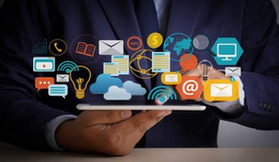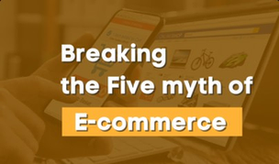
Back
WHAT IS OMNICHANNEL MARKETING?

What is omnichannel marketing?
-
Omnichannel marketing is a strategy that focuses on providing customers with a unified and consistent shopping experience across multiple sales channels.
-
This approach enables businesses to create a cohesive experience for customers by combining online, mobile, and in-person channels. This can include a combination of digital marketing, email campaigns, social media, in-store promotions, and direct mail.
-
By combining these different channels, businesses can provide customers with a seamless shopping experience that is tailored to their needs.
What are examples of omnichannel?
-
Delivery Services : Offering customers the ability to purchase items online and then pick them up in-store or have them delivered to their doorstep.
-
Mobile Apps : Allowing customers to shop and make purchases via their mobile phones.
-
Chatbots : Allowing customers to interact with a customer service agent via an automated chatbot.
-
Social Media Platforms : Allowing customers to shop, ask questions, and interact with customer service representatives through social media.
-
Interactive Voice Response (IVR) : Allowing customers to interact with customer service representatives through voice commands.
-
Multi-Platform Compatibility : Optimizing content across multiple platforms, such as mobile, desktop, and tablet, so customers have the same experience no matter which device they are using.
How has omnichannel been affected by the COVID-19 pandemic?
-
The COVID-19 pandemic has had a major impact on omnichannel retailing. Many retailers have had to shift their strategies to focus on digital channels in order to reach customers in an increasingly digital world.
-
Many retailers have seen a surge in online sales, while others have had to pivot to digital-only models to remain competitive.
-
In addition, many retailers have had to invest in technologies such as chatbots, automated customer service tools, and digital payment methods in order to keep up with the changing landscape. As customers become more accustomed to digital shopping, retailers must continue to invest in omnichannel capabilities to stay relevant and competitive.
What do customers want out of the omnichannel experience?
-
Seamless Shopping : Customers want to be able to switch between channels without experiencing any disruption in their shopping experience.
-
Personalization : Customers want to be recognized and treated as individuals. They expect personalized service and product recommendations tailored to their individual needs.
-
Variety : Customers want to be able to shop in a variety of ways, including in-store, online, mobile, and more.
-
Convenience : Customers want the ability to shop when, where, and how they want to. They expect to be able to visit stores, order online, and pick up items quickly and conveniently.
-
Quality : Customers expect a high-quality experience regardless of which channel they use to shop. This includes product quality, customer service, and the overall shopping experience.
Is omnichannel the same thing as phygital? And what is phygital, anyway?
-
No, omnichannel and phygital are not the same thing. Phygital is a combination of physical and digital experiences, where customers can interact with a physical product or location while also engaging with digital content.
-
This could include using a physical product such as a kiosk to access digital content, or a website that allows customers to view and purchase physical products.

The Regular myths around b2b e-commerce have to change. These are the persuading myths around b2b e-commerce.
What about omnichannel vs multichannel?
| Meaning | Multichannel Retailing is when a range of channels for selling a particular product across various platforms. | Omnichannel retailing is the use of various marketing channels, in a manner that facilitates the consumer an uninterrupted shopping experience. |
| Concept | Division between channels | Integration of all channels |
| Channel Focus | Interactive Channels only | Interactive and Mass Communication channels |
| Channel scope | Retail Channels: Store, e-commerce website and mobile. | Retail Channels: Store, Mobile, Website, Application, Social Media, Customer touch points. |
| View | Multiple views of customer for different digital channels. | A single view of the customer across all channels. |
| Focus | Maximum customer engagement | Maximum customer experience |
| Facilitates | It facilitates the marketer in connecting the dots concerning their customers. | It facilitates the marketer in connecting the dots concerning the brand. |
| Data | Not shared across channels | Shared across channels |
| Salespersons | Do not adapt selling behavior. | Adapt selling behaviour using different arguments depending on each customer’s needs and knowledge of the product. |
What is omnichannel personalization?
-
Omnichannel personalization is the practice of creating a unified and personalized experience across multiple customer touchpoints, such as online, in-store, mobile, and social media.
-
It involves using customer data to provide tailored content and experiences to each individual customer, regardless of what channel they are using. This helps to create a seamless customer experience and build stronger relationships with customers.
What is omnichannel strategy?
-
Omnichannel strategy is an approach to customer service that provides customers with a seamless experience across all channels, including online, in-store, mobile, and social media. It focuses on providing customers with consistent, personalized brand experiences across all channels.
-
The goal is to create a unified brand experience and establish clear channels of communication, so customers can easily find the products and services they need.
What’s involved in omnichannel operations?
-
Omnichannel operations involve providing a seamless customer experience across multiple channels of communication, such as online stores, mobile apps, and physical stores.
-
This requires having unified customer service processes, unified inventory management, unified data management and analytics, and unified marketing strategies across all channels.
-
Additionally, omnichannel operations involve developing a consistent brand experience across all channels, so that customers are met with the same look and feel no matter where they interact with the company.
What should I know about B2B omnichannel?
-
B2B omnichannel is a strategy that combines multiple digital and physical channels to create a unified customer experience.
-
The goal of B2B omnichannel is to create a seamless customer journey that allows customers to interact with a brand across multiple channels, such as online stores, physical stores, mobile apps, web portals, email, and more.
-
B2B omnichannel strategies should be tailored to the customer’s needs and preferences. This includes understanding the customer’s buying habits, preferences, and desired outcomes.
-
B2B omnichannel strategies should be integrated with other marketing efforts, such as content marketing, SEO, analytics, and more.
-
B2B omnichannel strategies should be continuously monitored and adapted to ensure a positive customer experience.






